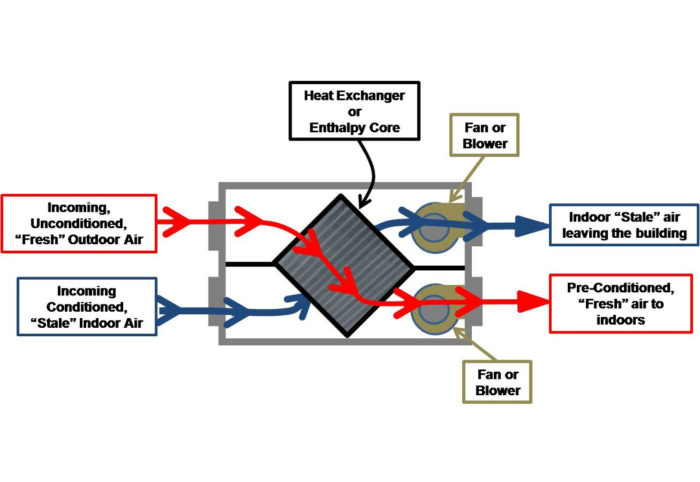Financial Insights with HRV in Variable Seasons
Wiki Article
Checking out the Benefits of Heat Recovery Ventilation for Energy Effectiveness in Homes
Heat Recovery Ventilation (HRV) systems use home owners a functional method to enhancing power efficiency. By redeeming warmth from outbound air, these systems can substantially reduce heating & cooling costs. In addition, they give a consistent supply of fresh air, enhancing interior air high quality and comfort degrees. As property owners take into consideration sustainable options, recognizing the nuances of HRV systems ends up being increasingly crucial. What elements should one review before making such an investment?Understanding Heat Recovery Ventilation Equipments

How HRV Enhances Indoor Air Quality

Energy Financial Savings: The Monetary Benefits of HRV
Taking full advantage of power effectiveness, heat recovery ventilation (HRV) systems use substantial monetary advantages for property owners. By recovering and recycling warm from exhaust air, HRVs considerably reduce cooling and heating expenses. This modern technology can bring about energy financial savings of as much as 30%, relying on environment and usage patterns. Home owners usually observe reduced energy bills shortly after setup, making HRVs a monetarily sensible investment in time. Furthermore, many areas supply motivations or refunds for energy-efficient upgrades, additionally enhancing the financial charm. As power rates remain to increase, the cost-effectiveness of HRVs becomes significantly clear. Generally, the consolidation of HRV systems not only promotes energy effectiveness but also adds to lasting economic savings for households.The Environmental Influence of Heat Recovery Ventilation
A substantial ecological benefit of heat recovery ventilation (HRV) systems hinges on their ability to decrease overall energy intake. By reclaiming heat from exhaust air and transferring it to incoming fresh air, HRV systems decrease the need for energy-intensive heating and cooling methods. This reduction in power demand adds to reduce greenhouse gas discharges, as less fossil fuel is called for to preserve comfortable interior temperatures. Furthermore, HRV systems enhance interior air top quality by effectively exchanging stagnant air with fresh exterior air, reducing dependence on mechanical air conditioning systems that can harm the setting. Overall, the execution of HRV systems sustains lasting living practices and HRV Heat Recovery Ventilation aligns with worldwide efforts to combat environment change by promoting power performance in household settings.
Selecting the Right HRV System for Your Home
Just how can homeowners guarantee they pick the best heat recovery ventilation (HRV) system for their needs? They need to analyze their home's size and layout, as these variables influence air flow requirements. Next off, examining the system's efficiency ratings is crucial, as greater ratings suggest better efficiency and energy savings. Home owners need to additionally take into consideration setup and maintenance prices, comparing various brand names and designs for value. In addition, it is very important to evaluate sound levels, as some systems operate even more quietly than others. Consulting with a/c professionals can give tailored referrals based on details home conditions. Analyzing customer reviews and service warranties can assist in making a notified choice, making sure that the selected HRV system efficiently boosts interior air top quality and power performance.Often Asked Inquiries

How Often Should I Tidy or Keep My HRV System?
The regularity of cleansing or maintaining a warm healing air flow (HRV) system typically relies on usage and environmental elements. Typically, it is suggested to carry out maintenance every six months to ensure peak efficiency and air top quality.
Can HRV Equipments Help In Reducing Moisture Degrees Indoors?
HRV systems can efficiently decrease indoor humidity degrees by trading stagnant, damp air with fresh, drier air from outside. HRV Heat Recovery Ventilation. This process assists preserve a balanced indoor atmosphere, enhancing comfort and preventing moisture-related problems
What Is the Life expectancy of a Regular HRV System?
The lifespan of a normal heat recovery ventilation (HRV) system varies, typically lasting between 10 to 15 years. Routine upkeep can prolong its efficiency and operational life, ensuring peak efficiency throughout its usage duration.Are There Any Noise Interest In HRV Solutions?
Noise worries with HRV systems can arise, particularly from fan operation. Numerous modern devices are designed to reduce audio degrees, guaranteeing they operate quietly while preserving effectiveness, which addresses potential disruptions in living environments.Can I Install an HRV System Myself, or Do I Need a Specialist?
The individual contemplated whether to mount the heat recovery ventilation (HRV) system personally or employ a professional. Normally, while DIY installation is feasible, proficiency warranties appropriate functionality and conformity with neighborhood building regulations, improving system efficiency.Report this wiki page